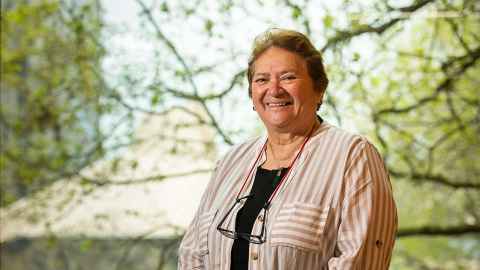Mate wareware and the power of te reo Māori
13 September 2022
Opinion: To mark Māori Language Week, Dr Makarena Dudley writes about the powerful effect of te reo on the well-being of kaumātua living with mate wareware (dementia).

The celebrations of Te Wiki o te Reo Māori this week provide us with a timely opportunity to honour the value of te reo as a vital healing and comforting factor for those who suffer from mate wareware (dementia).
Our research has shown that being able to use te reo Māori enables those with mate wareware to engage more fully in cultural activities and events - engagement which has been shown to be protective by slowing down or preventing the progression of this cruel condition.
Remarkably, whānau have reported that some kaumātua living with mate wareware have demonstrated an increased use of te reo Māori, which had been their first language but was suppressed in early childhood as a result of colonial practices. This tendency to revert to the first language in people who are bilingual is not uncommon, and some research shows that people who are bilingual may be more resilient to mate wareware than monolinguals.
The actual number of Māori affected by mate wareware is not yet known, but what we do know is that the number of kaumātua aged 65 years or older is rapidly increasing. A colonial history has resulted in the health of Māori being demonstrably poorer than the health of other New Zealanders as evidenced by the disproportionately high prevalence of health conditions that are risk factors for the onset of dementia, such as diabetes, cardiovascular disease, stroke, and a history of traumatic brain injuries.
Other factors that disadvantage Māori and can potentially lead to a higher incidence of mate wareware include being less likely to access primary care services, less likely to utilise mental health services, and more likely to be cared for within the whānau rather than reside in long-term care facilities where they are more visible.
Furthermore, Māori are also socially and economically deprived, which also places them at further risk for getting mate wareware.
Due to the health inequities that exist for Māori the need for research into mate wareware is all the more urgent if we are to prevent a tsunami of this disease. Crucial to the management of mate wareware is knowing what the protective factors are for slowing down the progression of this disease or even its prevention.
In our study Mate wareware: Understanding 'dementia' from a Māori perspective, the first ever to investigate the understanding and experiences of mate wareware from a Māori perspective, more than 300 kaumatua and whānau from across the country were interviewed. The kaumātua commented on many aspects of mate wareware including how it is perceived from a Māori worldview, what their beliefs are about its causes, how it should be managed and what they believed to be some protective factors against getting it.
Traditional values and practices of Māori culture that centre on the oranga (wellbeing) of the whānau, hapū, and iwi provide an ideal environment for caring for people with mate wareware. This was demonstrated by many whānau who spoke positively of how they had come together to pool resources and share the care needs of their kaumātua with mate wareware. It was also evident from the unconditional aroha and compassion these whānau demonstrated that there were benefits to the whole whānau that resulted from this traditional way of caring.
An important finding from this study were the many reports from kaumātua that listening to te reo Māori and being engaged in a range of cultural activities promoted wellbeing and maintained a person’s ability to be socially active. This finding is consistent with the many studies that have shown increased social engagement and cognitive lifestyle activities have been associated with a decreased risk or slowing down of cognitive decline and dementia.
At the heart of a whānau environment or being on a marae and in the company of other kaumātua is the opportunity to speak and hear te reo Māori. Te reo Māori is much more than a language of communication, it contains within it the fields of Māori philosophy and knowledge that is at the heart of Māori culture, heritage and wellbeing. Te reo Māori is central to the wairuatanga (spirituality) of Māori.
And using kupu Māori to describe the condition is also of huge significance when dealing with individuals and whānau affected by the condition. Mate (which means sick) and wareware (forgetful or forgotten) is free of the negativity, fear and stigma that Māori feel is associated with the Western term dementia. In te ao Māori, mate wareware is not necessarily perceived in an adverse way.
The extent and importance of te reo as central to the health and wellbeing in Māori was beautifully expressed by one kaumātua who said “This is the hinengaro [psychological dimension]. We can sit here, close our eyes, comprehend everything that is being said, because we are listening not just with our ears, but with our minds, with our souls and whole physical being”.
Researchers are keen to further investigate what other protective factors may exist, embedded in the practices of Māori culture, and have begun a three-year study into mate wareware, the first ever to be Indigenous-led.
Dr Makarena Dudley is a senior lecturer in the Faculty of Science School of Psychology and Director of University Research in the Faculty of Medical and Health Science’s Centre for Brain Research.
This article reflects the opinion of the author and not necessarily the views of the University of Auckland.
Used with permission from Newsroom Te reo Māori’s unknown health benefits 13 September 2022
Media queries
Alison Sims | Media adviser
E: alison.sims@auckland.ac.nz